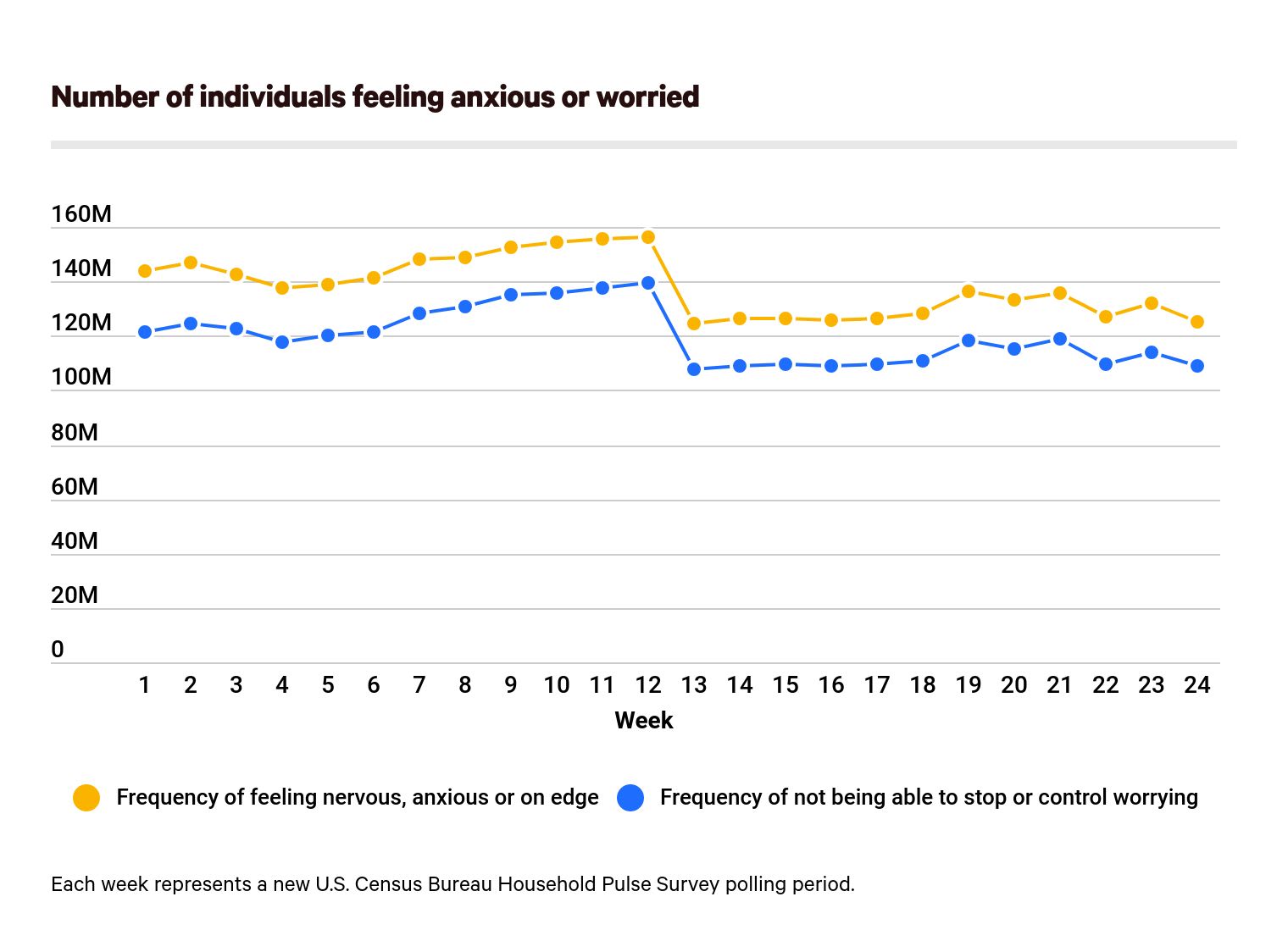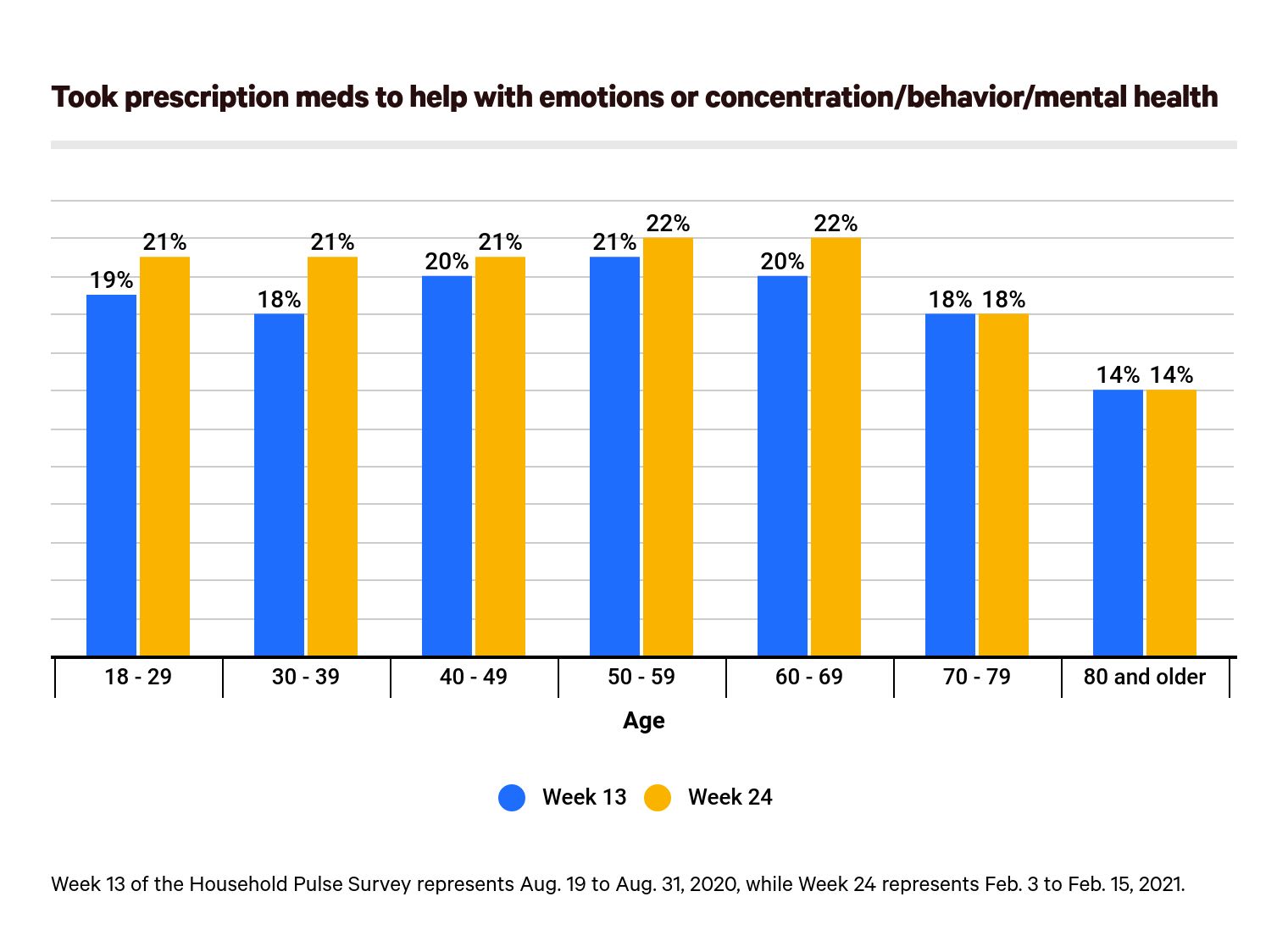Nearly 19 million fewer Americans are anxious than early in the pandemic but older generations generally have not reported the same mental health gains.
The coronavirus pandemic has forced many Americans to deal with stressful situations, requiring flexibility and decision-making that they didn’t know they needed. With vaccinations continuing to ramp up, the U.S. may be turning a corner a year after the start of the deadly crisis.
With this in mind, ValuePenguin analyzed U.S. Census Bureau Household Pulse Survey data to gain a picture of mental health, from nervousness and depression to counseling and prescription drugs. The survey has been conducted since April 23, 2020, providing us a deeper understanding of how American households have adapted over the course of the pandemic. Here’s what we found.
Key findings
With declining rates of anxiety since early in the pandemic, Americans are showing an eagerness to return to normal and optimism for the future
As the survey data shows, 13% fewer Americans as of mid-February are feeling anxious or nervous compared to late April. Specifically, more than 144 million Americans in April reported feeling nervous, anxious or on edge at least several days a week. That number now stands at 125.1 million, a decrease of 18.9 million Americans.

The U.S. Census Bureau survey has also been asking Americans whether they feel they’ve not been able to stop or control worrying. In late April, 121.6 million Americans reported this, compared to 109 million in mid-February — a 10% decrease.
Overall, younger Americans saw some of the largest decreases when looking at anxiousness and worrying. Americans ages 30 to 39 reported a 19% drop in nervousness and 18% drop in worrying during the April-to-February period, while Americans ages 20 to 29 reported decreases of 16% and 14%, respectively.
Men (11%) and women (10%) were nearly identical when responding about controlling their worrying.
Americans have not only felt less nervous, but 5% fewer individuals have reported feeling depressed — with younger individuals showing the largest improvement
In late April, 109.3 million people said they felt down, depressed or hopeless at least several days a week. Within that group, 18% reported feeling this way nearly every day. Fortunately, many Americans are on the mend, as 5.3 million fewer people reported the same as of mid-February.

Tracking depression by age group has followed similar patterns as feelings of anxiousness or nervousness, with a 14% drop seen among 30- to 39-year-olds. The rate of women feeling depressed has decreased 6% since late April — double the 3% rate among men.
Meanwhile, many Americans have lost income during the pandemic because of a job loss or salary cut. This can boost stress when money is tight. In late April, 60.2 Americans with income loss reported feelings of depression, versus 58.2 million Americans in mid-February — a decrease of 3%. This means that some Americans may have recouped lost jobs or salaries.
Americans ages 60 to 69 are reporting increased depression, while those 80 and older are reporting the same — plus increased anxiousness and worrying
Older generations are generally more anxious now than they were in mid-February. In late April, 2.2 million adults 80 and older reported nervousness and anxiousness, but that figure has risen 20% to 2.7 million adults.
On a similar note, the feeling of not being able to control worry increased by 25% for those 80 and older, while depression increased by 12% — both troubling numbers for the most vulnerable.
When comparing these figures to those of younger generations, the differences are staggering. For example, 18- to 29-year-olds reporting feelings of nervousness and anxiousness dropped 16% in the April-to-February period — a difference of 36 percentage points compared to those 80 and older.
| 60-69 | -6% | -2% | 1% | 3% |
| 70-79 | -2% | 4% | -2% | -1% |
| 80 and older | 20% | 25% | 14% | 12% |
{“alignsHorizontal”:[“left”,”right”,”right”,”right”,”right”],”alignsVertical”:[],”columnWidths”:[],”data”:[[“Age”,”Feeling nervous, anxious or on edge”,”Not being able to stop or control worrying”,”Having little interest or pleasure in doing things”,”Feeling down, depressed or hopeless”],[“60-69″,”-6%”,”-2%”,”1%”,”3%”],[“70-79″,”-2%”,”4%”,”-2%”,”-1%”],[“80 and older”,”20%”,”25%”,”14%”,”12%”]],”footnote”:”Change in sentiment since April 23rd, 2020″,”hasMarginBottom”:true,”isExpandable”:true,”isSortable”:false,”maxWidth”:”1215″,”showSearch”:false,”sortColumnIndex”:0,”sortDirection”:”asc”}
Pinpointing why older individuals are feeling this way is difficult. Following federal mandates, these individuals are generally receiving vaccinations first which would presumably lead to lower levels of worry. However, a return to normal day-to-day activities could be the quickest way to decrease feelings of nervousness or depression and consider consulting a doctor if you are having feelings of nervousness and depression.
Decreasing levels of anxiety, nervousness and depression could be occurring due to rising levels of counseling
The Household Pulse Survey added a new variable on Aug. 19 that looked at the mental health activities a person has engaged in over the prior four weeks. Questions included whether respondents had received counseling, considered therapy or taken prescription medication for help with emotions, behavior or their mental health.
Overall, the percentage of people who received counseling or went to therapy increased by 15% since mid-August, or by 2.6 million Americans. Furthermore, 23% more people reported needing to visit a therapist but not going for any reason.
Most age groups reported increasing their usage of counseling, with 30- to 39-year-olds seeing a 30% jump. However, 70- to 79-year-olds decreased therapy usage by 16% over that period.

In addition to the rising usage of counseling and therapy, the use of prescription drugs to help with emotions, behavior or mental health rose significantly. The 80-and-older group increased usage the most at 29%, with 30- to 39-year-olds up next at 15%. Overall, the number of people taking prescription drugs rose by 2 million, or 5%.

Using health insurance to aid with therapy bills
With people increasingly turning to health professionals for counseling and therapy, more people may find they need to utilize their health insurance to cover these fees. Consumers who are covered should be aware of their deductibles to understand what they may need to pay out of pocket.
Furthermore, it’s important to gain an understanding of different provider networks since some therapists may not be covered under specific health insurance policies.
For those individuals who aren’t covered by health insurance but need counseling help, there are options. Many therapists allow you to pay for their services directly. However, this can be costly. For affordable therapy, there may be local social services in your area or nonprofits that can offer help.
Methodology
ValuePenguin analyzed data from the U.S. Census Bureau’s Household Pulse Survey, which has been conducted since April 23, 2020.
In phase one of the survey — April 23 to July 21 — data was presented weekly. In phase two — Aug. 19 to Oct. 26 — and phase three — Oct. 28, 2020, to Feb. 15, 2021 — data was presented biweekly.
Mentions of the most recent period cover Feb. 3 to Feb. 15, although the survey was expected to continue through March 1.
